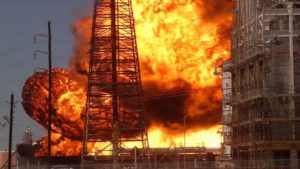The management of a company is always ultimately responsible for the safety of its employees. In the process industry, it is crucial to pay close attention to safety assurance, as hazardous substances are often handled, there is a risk of explosions, powerful (dangerous) installations are operational, and so on.
Read also: Who is responsible for process safety in a factory? »
SIL, SIF, and SIS
There are many potential hazards in the process industry. Therefore, besides the existing machine monitoring systems, it is of great importance to have competent employees to ensure an optimal and safe working environment. The management of a company is responsible for safety in a factory. This is done by utilizing Safety Instrumented Systems (SIS) and Safety Instrumented Functions (SIF). The SIS and SIF need to be properly controlled and can be SIL (Safety Integrity Level) certified. The higher the SIL level, the lower the risk of a SIS or SIF failing when it needs to intervene. However, this does not mean that choosing a higher SIL level is always better. This often results in additional costs and documentation, which may not be necessary. The required SIL level is determined based on the risk related to the application. For example, certifying a machine (component) as SIL 3 is pointless if the frequency of malfunctions is very low and the consequential damage is minimal.
Company Culture and Safety
Investing in safety costs money, and spending money reduces profits. Although profit should not be a motive to skip safety measures, this is often the case. Management is often under high pressure and expected to maximize profits. While investing in safety measures can reduce workplace accidents, minimize maintenance requirements, and reduce the need for spare parts, these benefits are not immediately apparent when funding the necessary safety measures. A paradox arises; management is responsible for investing in the safety of employees and the plant, but is simultaneously under pressure to spend as little money as possible. It is crucial that a company’s current corporate culture allows for the necessary safety measures to be taken. Although profit is always a consideration for a commercial company, there should be a corporate culture where safety is paramount. Besides being mandatory to provide state-of-the-art safety measures, a company creates a pleasant and safe working environment in this way. This also boosts employee morale.
Consistency and Safety
In addition to money, consistency plays a significant role in safety. Consistently adhering to regulations/protocols is crucial. The company culture also greatly influences this aspect. Most accidents in a company result from human error. Breaking certain habits, such as machine inspection, can eventually result in a machine malfunction with its consequences. Therefore, it is crucial that every user of a machine follows the same regulations/protocols to prevent dangerous situations. Every employee has a role within a company. It is important that the existing company culture allows these roles to be performed properly. For example, excessive workload could lead to certain tasks not being performed fully or not at all. Although safety-related tasks are often checked by many people, shifting responsibilities can lead to, sometimes catastrophic, malfunctions. The likelihood of actual failure is very low, but this risk should ideally not exist. As discussed in the article on LOPA, there are many layers of protection designed to minimize risks as much as possible. If one layer of protection fails, the next layer should compensate for the failure. However, errors in performing checks can create ‘gaps’ in these layers of protection, ultimately resulting in damage or, worse, a fire and/or explosion.
Practical Example
Below is a scenario outlined of a series of events that could lead to serious consequences. Although the scenario may seem unlikely, it is an event that actually occurred.
Company X is a gas plant that shuts down periodically for a full overhaul of all operational machinery. This is carried out by multiple maintenance teams performing various measurements and checks on the machines (components). The CEO of Company X wants the safety manager to expedite the process because the downtime of the factory is costing too much money. Certain maintenance teams will be eliminated, resulting in incomplete work. However, the factory will be operational again quickly, leading to significant cost savings. The engineering manager is concerned; he believes that more maintenance is necessary, not less. The corrosion inspection will have to be skipped. An engineer complains to a senior engineer that the workload is too high due to the elimination of some maintenance teams. However, the senior engineer is under a lot of pressure and wants the “most important tasks” to be thoroughly completed while the “less important tasks,” including the corrosion inspection, are skipped. The corrosion report is still prepared without conducting the inspection. The report is signed by the maintenance supervisor without being reviewed. Additionally, incorrect, unsigned installation instructions were given to the worker who was supposed to replace a pipeline. Although he has doubts about the instructions, he follows them as described because they were signed by many people in higher positions, and he does not want to question them. Due to improper installation, vibrations occurred, leading to hydrocarbons leaking from the pipeline over time in combination with corrosion. These reached an ignition source, resulting in an explosion at the gas plant, causing fatalities.

Although the chance may be one in a million, every possible scenario will eventually occur. If each of the aforementioned stakeholders had performed their tasks according to regulations/protocols, this explosion would never have occurred. However, the company culture did not allow this. The CEO focused too much on profitability and wanted the factory to be operational again too quickly. This led employees in various positions to be more or less compelled to perform their work incompletely or not at all. Additionally, too much reliance was placed on the accuracy of the report and instructions. Despite many people having doubts, no one voiced them.

